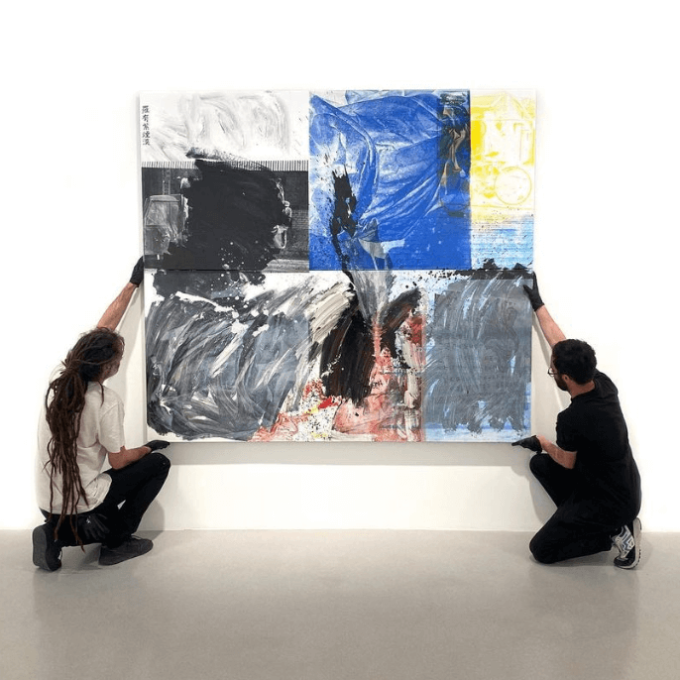
Installation view of "Testimony (Japanese Claywork)" (1985), Thaddaeus Ropac Paris Marais, June 2023
Robert Rauschenberg: Japanese Clayworks at Thaddaeus Ropac Paris Marais, June 6–July 29, 2023
Robert Rauschenberg: Japanese Clayworks
Thaddaeus Ropac Paris Marais
June 6 – July 29, 2023
Rarely seen works from a formative series to be exhibited at Thaddaeus Ropac Paris Marais in collaboration with the Robert Rauschenberg Foundation.
Thaddaeus Ropac Paris Marais presents a selection of key works on ceramic by Robert Rauschenberg from the 1980s. Spanning works from the artist’s Japanese Clayworks series (1982/1985), as well as a further group of ceramics made in 1989 as a continuation of this earlier series, the exhibition highlights a formative period in the artist’s career.
Over the course of 15 years, Rauschenberg made several trips to Japan, where he collaborated with the Otsuka Ohmi Ceramics Company (OOCC) in Shigaraki to create ceramic artworks using a newly developed technique that combined ancient Japanese pottery traditions with modern innovations. He worked with local chemists to produce glazes that allowed him to silkscreen his own photographs onto transfer sheets, which were then removed from their backing, affixed to the surface of ceramic panels, and fired in the kiln. Japanese Clayworks is the first series of works that Rauschenberg made at the OOCC.
The Japanese Clayworks on view in the exhibition incorporate silkscreened photographs, both black-and-white and colour, taken by Rauschenberg throughout the late 1970s and early 1980s across North and South America and Asia. Reprising important motifs from across his practice, such as wheels and modes of transportation, garden decorations that recall Classical sculpture, and landscapes that are alternately idyllic and strewn with industrial or urban debris, the artist’s specific arrangements of these diverse images give the works a potency that goes beyond that of the individual images themselves, encouraging viewers to attempt to decipher them, while ultimately refusing any single interpretative meaning.
By 1985, when these Japanese Clayworks were made, Rauschenberg was already silkscreening his black-and-white photographs onto a variety of supports, including canvas drop cloths in his Salvage series (1983–85) and metal. His Japanese Clayworks, however, mark the first instance in which Rauschenberg incorporated his colour photographs into some artworks. The vibrant images are mingled with found patterns from mass-produced Japanese ceramics, and overlaid with the artist’s own gestural brushstrokes. These expressive strokes offset the glassy ceramic surface of the works, reintroducing a painterly quality to blur boundaries between artistic categories.
The Japanese Clayworks in the exhibition are accompanied by a further group of ceramic works, made in 1989, when Rauschenberg once again collaborated with the OOCC. In his Captiva, Florida studio, he created the compositions that would form their ground, using his solvent transfer technique and adding strokes of acrylic and sometimes paper collage. He then created the transfer sheets for each work individually, before sending the components to the OOCC, where his imagery was transferred onto its fine but robust ceramic supports.
On the transfer sheet for each work, the artist added touches of bold brushwork in primary colours. These gestures, which are unique to each work, contribute to the dialogue between the mechanically reproduced image and the artist’s hand which is central to Rauschenberg’s practice. On each transfer sheet, the artist also signed his name in his characteristic capital letters, as well as in kanji, a form of Japanese writing adapted from Chinese characters. Through signing in both languages, Rauschenberg claimed authorship while also paying respect to the cultural context in which the works were made and by which they were inspired.
I think collaboration is a prescription or device that keeps one from getting hung up on a strong single intention that blinds. [...] Every individual that you add to a project will result in ten times as many possibilities.
Robert Rauschenberg, 1987
Travel, always accompanied by exploration of local materials and collaboration with local artisans, was a fundamental part of Rauschenberg’s artistic practice. Through his work, he searched for how he, as an artist, could respond to pressing political, environmental and social challenges, contribute to peace and cross-cultural understanding and produce universally meaningful images in an increasingly global world. His collaboration with the OOCC provided a model for the Rauschenberg Overseas Culture Interchange (ROCI): a project realised in ten countries, including Japan, through which, beginning in 1984, the artist worked to encourage international dialogue through artistic collaboration.
Another of Rauschenberg’s works on ceramic is part of the exhibition L’Argent dans l’art, on view at the Monnaie de Paris until 24 September 2023. Made at the OOCC during the same period in which the artist was making the Japanese Clayworks presented at Thaddaeus Ropac Paris Marais, this 1983 work belongs to his series of Japanese Recreational Clayworks, which was inspired by the reproductions of historical Western artworks on ceramic panels that the OOCC specialised in manufacturing. In the work on view at the Monnaie de Paris, Rauschenberg combined well-known 19th-century oil paintings by Edgar Degas and Jean-François Millet, before adding his own painterly interventions in order to invite new interpretations of the original artworks.
Japanese Clayworks at Thaddaeus Ropac Paris Marais is presented in cooperation with the Robert Rauschenberg Foundation. Thaddaeus Ropac gallery has been a partner of the Robert Rauschenberg Foundation since April 2015 and the partnership has resulted in a series of exhibitions, focusing on some of the artist’s most innovative and under-recognised series of the 1970s, 1980s and early 1990s, including his Night Shades, Phantoms, Borealis, Salvage paintings and Spreads. For further information on the mission and programmes of the Foundation, visit www.rauschenbergfoundation.org and follow them on Instagram at @rauschenbergfoundation.
For more information: https://ropac.net/exhibitions/668-robert-rauschenberg-japanese-clayworks/
For any enquiries: Marcus Rothe
Thaddaeus Ropac Paris
marcus.rothe@ropac.net
Thaddaeus Ropac Paris Marais
Telephone +33 1 42 72 99 00
Mobile +33 6 76 77 54 15
